The Changing Economics of Asia: A Report on Taiwan's Agriculture
VerifiedAdded on 2021/04/16
|13
|3349
|63
Report
AI Summary
This report provides a comprehensive analysis of Taiwan's agricultural sector within the context of the changing economics of Asia. It begins with an introduction to the importance of agriculture in economic development, particularly in developing countries, and then focuses on Taiwan as a case study. The report explores key aspects of Taiwan's agricultural sector, including its background, role in the economy, and the impact of the Green Revolution. It discusses land reform initiatives and examines problems and setbacks faced by the sector, such as climate change and international market competition. The report concludes with an overview of the findings, emphasizing the sector's historical significance and its ongoing challenges and prospects in the context of broader economic transformations in Asia.
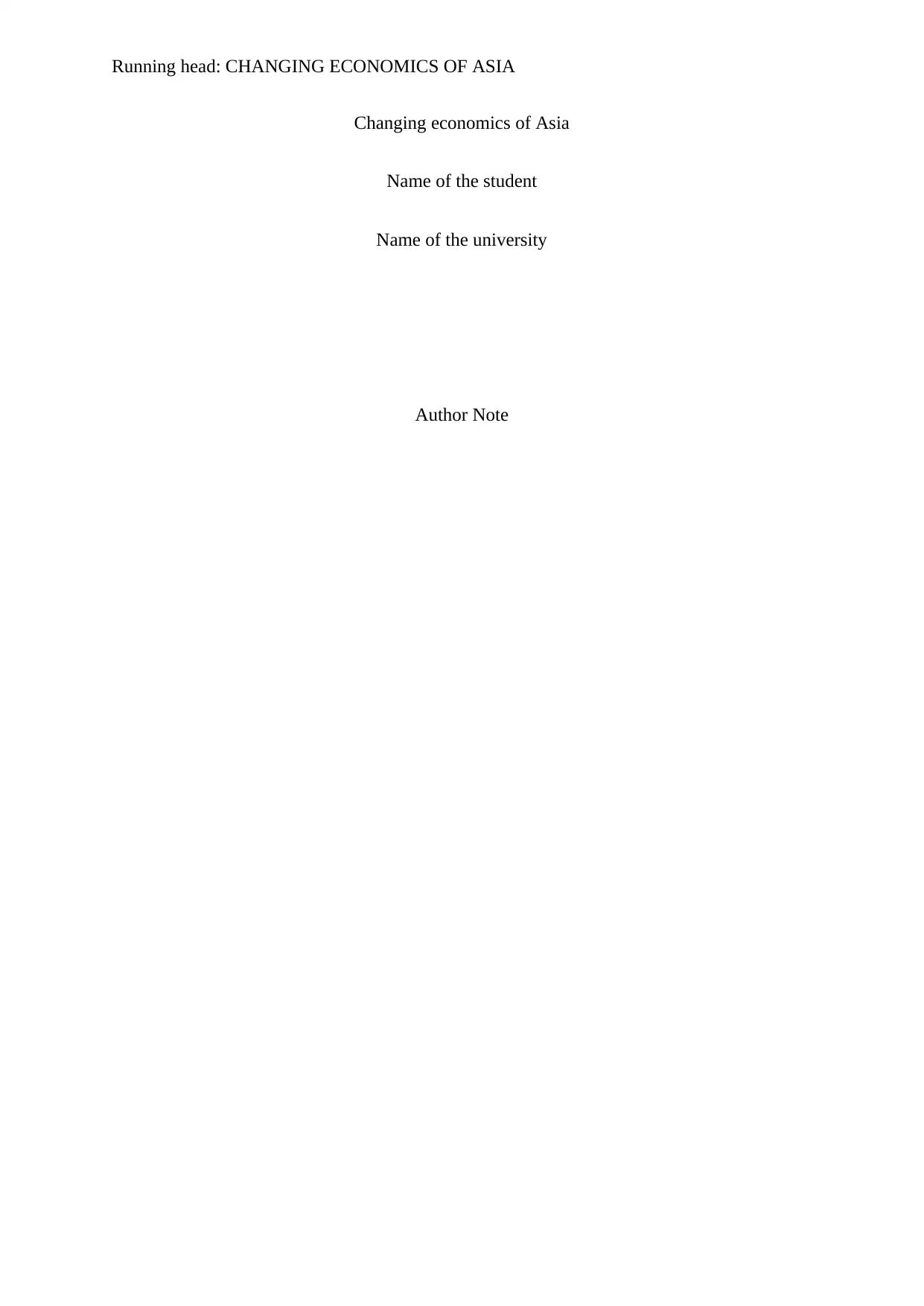
Running head: CHANGING ECONOMICS OF ASIA
Changing economics of Asia
Name of the student
Name of the university
Author Note
Changing economics of Asia
Name of the student
Name of the university
Author Note
Paraphrase This Document
Need a fresh take? Get an instant paraphrase of this document with our AI Paraphraser
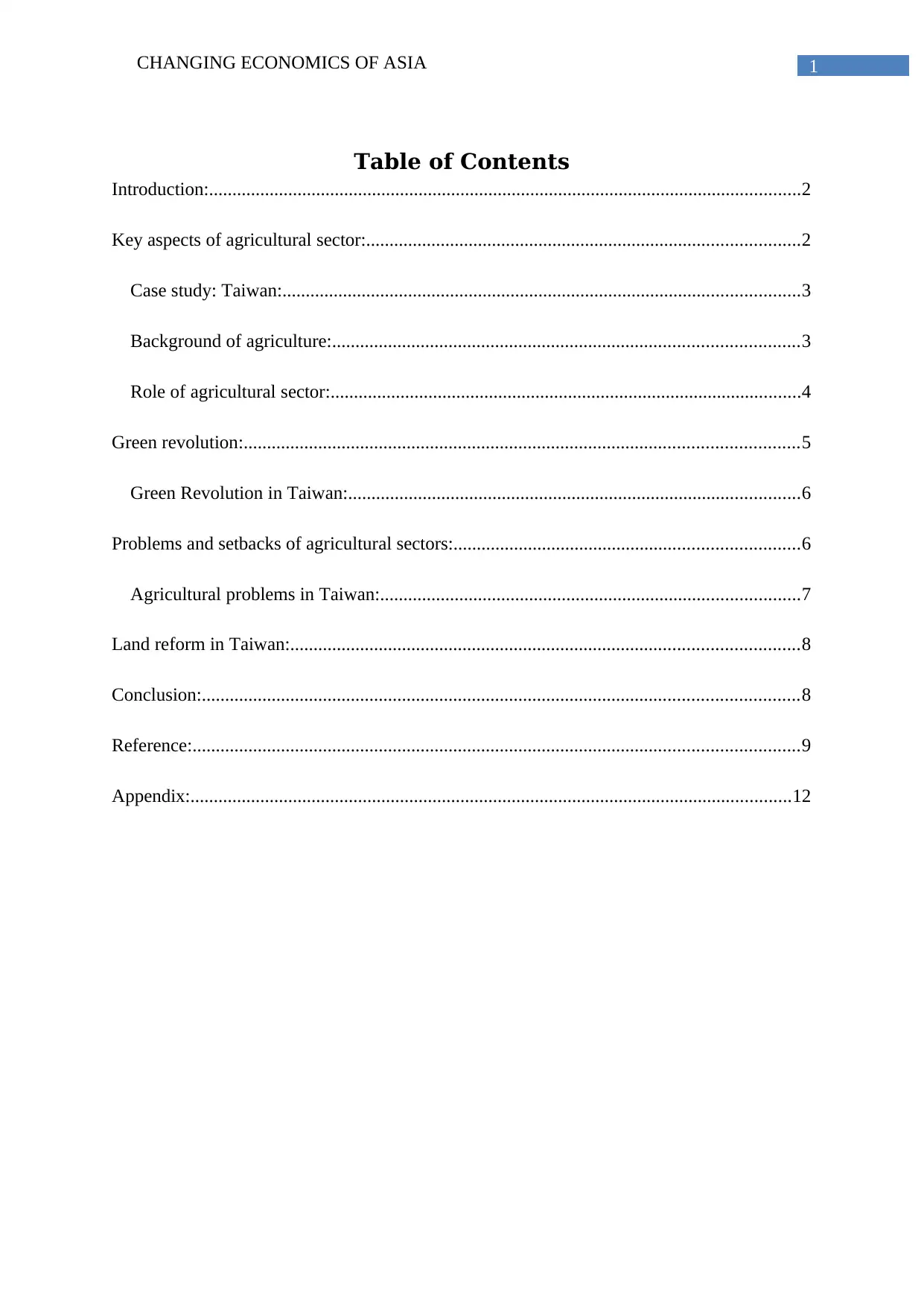
1CHANGING ECONOMICS OF ASIA
Table of Contents
Introduction:...............................................................................................................................2
Key aspects of agricultural sector:.............................................................................................2
Case study: Taiwan:...............................................................................................................3
Background of agriculture:....................................................................................................3
Role of agricultural sector:.....................................................................................................4
Green revolution:.......................................................................................................................5
Green Revolution in Taiwan:.................................................................................................6
Problems and setbacks of agricultural sectors:..........................................................................6
Agricultural problems in Taiwan:..........................................................................................7
Land reform in Taiwan:.............................................................................................................8
Conclusion:................................................................................................................................8
Reference:..................................................................................................................................9
Appendix:.................................................................................................................................12
Table of Contents
Introduction:...............................................................................................................................2
Key aspects of agricultural sector:.............................................................................................2
Case study: Taiwan:...............................................................................................................3
Background of agriculture:....................................................................................................3
Role of agricultural sector:.....................................................................................................4
Green revolution:.......................................................................................................................5
Green Revolution in Taiwan:.................................................................................................6
Problems and setbacks of agricultural sectors:..........................................................................6
Agricultural problems in Taiwan:..........................................................................................7
Land reform in Taiwan:.............................................................................................................8
Conclusion:................................................................................................................................8
Reference:..................................................................................................................................9
Appendix:.................................................................................................................................12
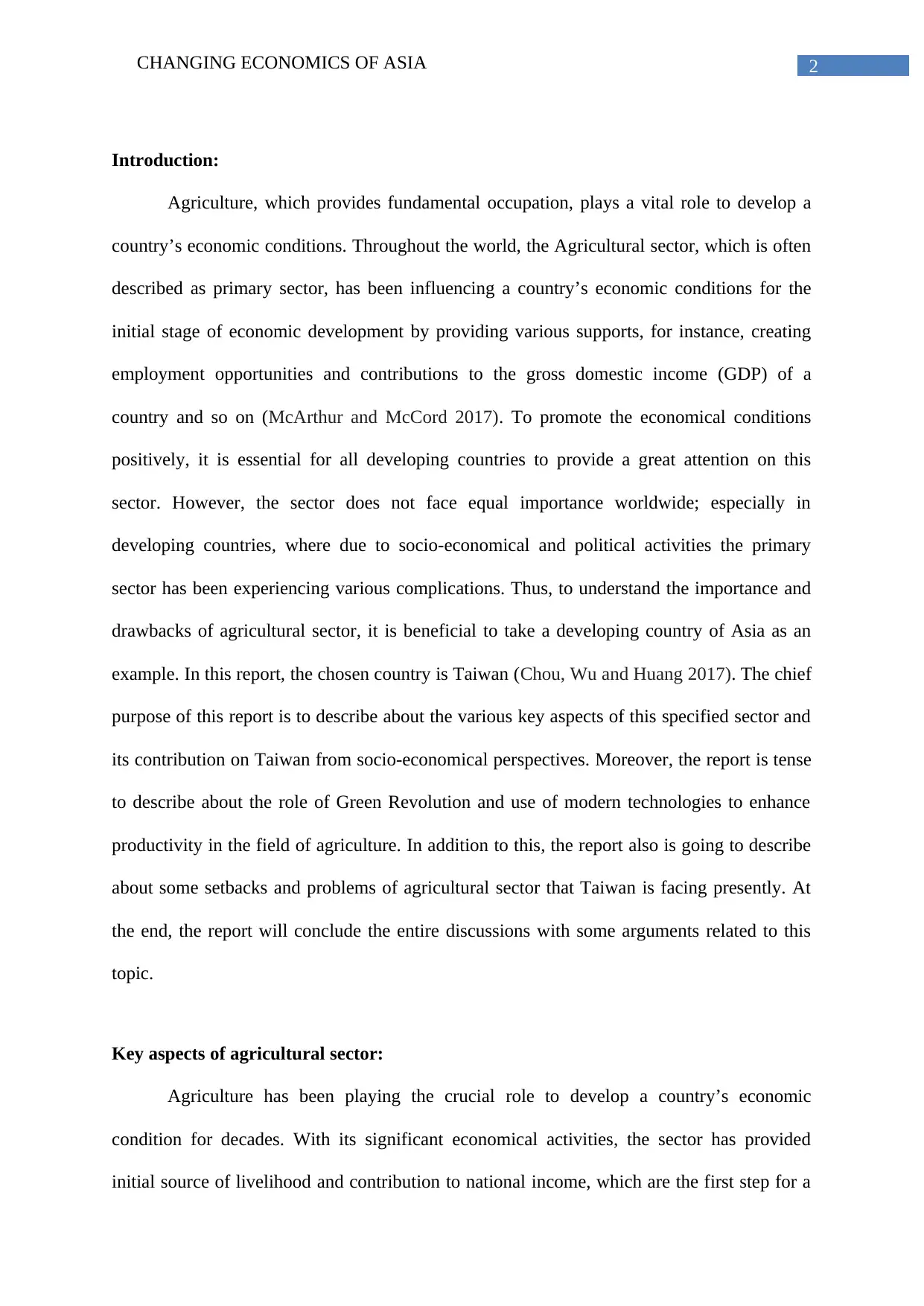
2CHANGING ECONOMICS OF ASIA
Introduction:
Agriculture, which provides fundamental occupation, plays a vital role to develop a
country’s economic conditions. Throughout the world, the Agricultural sector, which is often
described as primary sector, has been influencing a country’s economic conditions for the
initial stage of economic development by providing various supports, for instance, creating
employment opportunities and contributions to the gross domestic income (GDP) of a
country and so on (McArthur and McCord 2017). To promote the economical conditions
positively, it is essential for all developing countries to provide a great attention on this
sector. However, the sector does not face equal importance worldwide; especially in
developing countries, where due to socio-economical and political activities the primary
sector has been experiencing various complications. Thus, to understand the importance and
drawbacks of agricultural sector, it is beneficial to take a developing country of Asia as an
example. In this report, the chosen country is Taiwan (Chou, Wu and Huang 2017). The chief
purpose of this report is to describe about the various key aspects of this specified sector and
its contribution on Taiwan from socio-economical perspectives. Moreover, the report is tense
to describe about the role of Green Revolution and use of modern technologies to enhance
productivity in the field of agriculture. In addition to this, the report also is going to describe
about some setbacks and problems of agricultural sector that Taiwan is facing presently. At
the end, the report will conclude the entire discussions with some arguments related to this
topic.
Key aspects of agricultural sector:
Agriculture has been playing the crucial role to develop a country’s economic
condition for decades. With its significant economical activities, the sector has provided
initial source of livelihood and contribution to national income, which are the first step for a
Introduction:
Agriculture, which provides fundamental occupation, plays a vital role to develop a
country’s economic conditions. Throughout the world, the Agricultural sector, which is often
described as primary sector, has been influencing a country’s economic conditions for the
initial stage of economic development by providing various supports, for instance, creating
employment opportunities and contributions to the gross domestic income (GDP) of a
country and so on (McArthur and McCord 2017). To promote the economical conditions
positively, it is essential for all developing countries to provide a great attention on this
sector. However, the sector does not face equal importance worldwide; especially in
developing countries, where due to socio-economical and political activities the primary
sector has been experiencing various complications. Thus, to understand the importance and
drawbacks of agricultural sector, it is beneficial to take a developing country of Asia as an
example. In this report, the chosen country is Taiwan (Chou, Wu and Huang 2017). The chief
purpose of this report is to describe about the various key aspects of this specified sector and
its contribution on Taiwan from socio-economical perspectives. Moreover, the report is tense
to describe about the role of Green Revolution and use of modern technologies to enhance
productivity in the field of agriculture. In addition to this, the report also is going to describe
about some setbacks and problems of agricultural sector that Taiwan is facing presently. At
the end, the report will conclude the entire discussions with some arguments related to this
topic.
Key aspects of agricultural sector:
Agriculture has been playing the crucial role to develop a country’s economic
condition for decades. With its significant economical activities, the sector has provided
initial source of livelihood and contribution to national income, which are the first step for a
⊘ This is a preview!⊘
Do you want full access?
Subscribe today to unlock all pages.

Trusted by 1+ million students worldwide
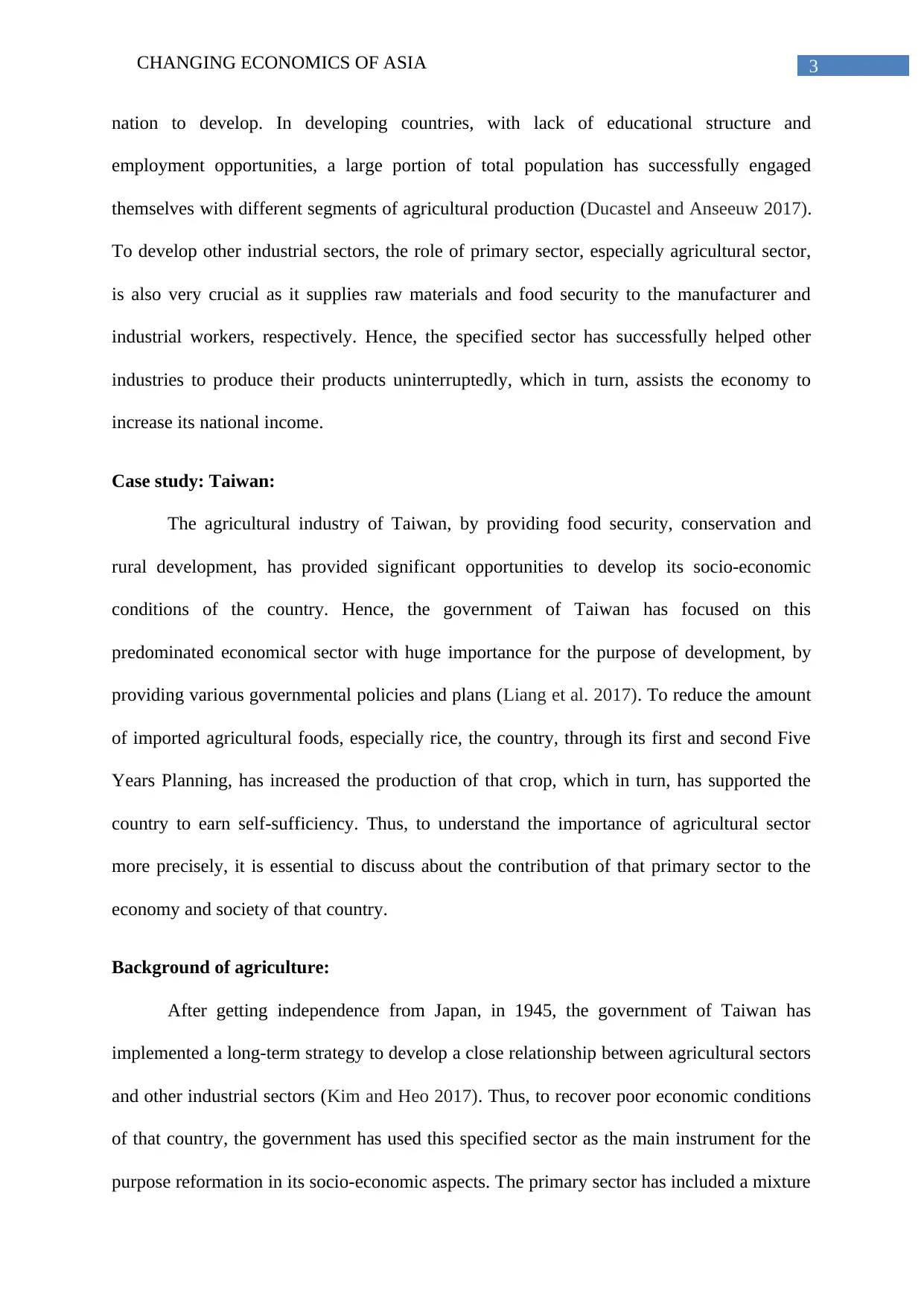
3CHANGING ECONOMICS OF ASIA
nation to develop. In developing countries, with lack of educational structure and
employment opportunities, a large portion of total population has successfully engaged
themselves with different segments of agricultural production (Ducastel and Anseeuw 2017).
To develop other industrial sectors, the role of primary sector, especially agricultural sector,
is also very crucial as it supplies raw materials and food security to the manufacturer and
industrial workers, respectively. Hence, the specified sector has successfully helped other
industries to produce their products uninterruptedly, which in turn, assists the economy to
increase its national income.
Case study: Taiwan:
The agricultural industry of Taiwan, by providing food security, conservation and
rural development, has provided significant opportunities to develop its socio-economic
conditions of the country. Hence, the government of Taiwan has focused on this
predominated economical sector with huge importance for the purpose of development, by
providing various governmental policies and plans (Liang et al. 2017). To reduce the amount
of imported agricultural foods, especially rice, the country, through its first and second Five
Years Planning, has increased the production of that crop, which in turn, has supported the
country to earn self-sufficiency. Thus, to understand the importance of agricultural sector
more precisely, it is essential to discuss about the contribution of that primary sector to the
economy and society of that country.
Background of agriculture:
After getting independence from Japan, in 1945, the government of Taiwan has
implemented a long-term strategy to develop a close relationship between agricultural sectors
and other industrial sectors (Kim and Heo 2017). Thus, to recover poor economic conditions
of that country, the government has used this specified sector as the main instrument for the
purpose reformation in its socio-economic aspects. The primary sector has included a mixture
nation to develop. In developing countries, with lack of educational structure and
employment opportunities, a large portion of total population has successfully engaged
themselves with different segments of agricultural production (Ducastel and Anseeuw 2017).
To develop other industrial sectors, the role of primary sector, especially agricultural sector,
is also very crucial as it supplies raw materials and food security to the manufacturer and
industrial workers, respectively. Hence, the specified sector has successfully helped other
industries to produce their products uninterruptedly, which in turn, assists the economy to
increase its national income.
Case study: Taiwan:
The agricultural industry of Taiwan, by providing food security, conservation and
rural development, has provided significant opportunities to develop its socio-economic
conditions of the country. Hence, the government of Taiwan has focused on this
predominated economical sector with huge importance for the purpose of development, by
providing various governmental policies and plans (Liang et al. 2017). To reduce the amount
of imported agricultural foods, especially rice, the country, through its first and second Five
Years Planning, has increased the production of that crop, which in turn, has supported the
country to earn self-sufficiency. Thus, to understand the importance of agricultural sector
more precisely, it is essential to discuss about the contribution of that primary sector to the
economy and society of that country.
Background of agriculture:
After getting independence from Japan, in 1945, the government of Taiwan has
implemented a long-term strategy to develop a close relationship between agricultural sectors
and other industrial sectors (Kim and Heo 2017). Thus, to recover poor economic conditions
of that country, the government has used this specified sector as the main instrument for the
purpose reformation in its socio-economic aspects. The primary sector has included a mixture
Paraphrase This Document
Need a fresh take? Get an instant paraphrase of this document with our AI Paraphraser
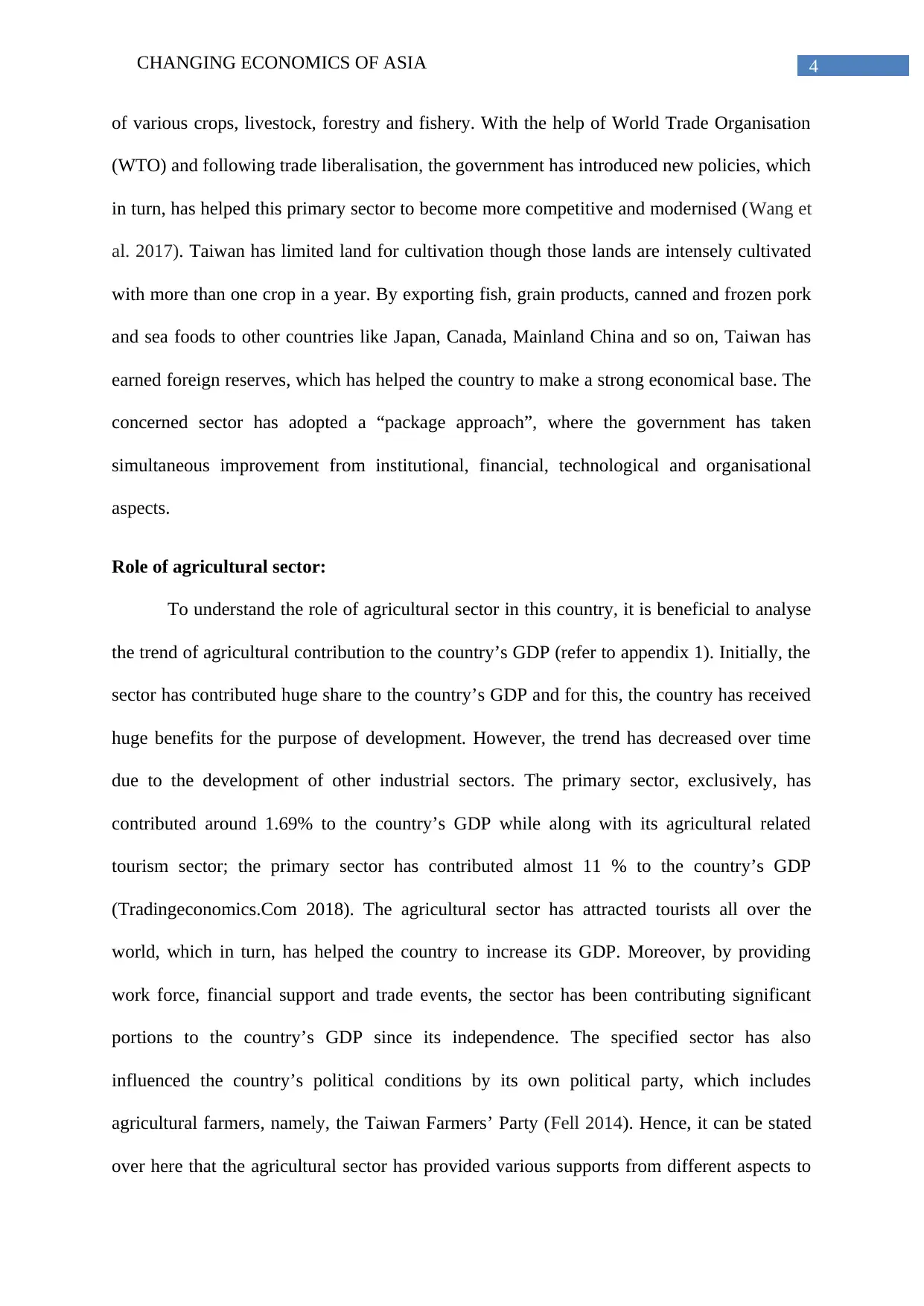
4CHANGING ECONOMICS OF ASIA
of various crops, livestock, forestry and fishery. With the help of World Trade Organisation
(WTO) and following trade liberalisation, the government has introduced new policies, which
in turn, has helped this primary sector to become more competitive and modernised (Wang et
al. 2017). Taiwan has limited land for cultivation though those lands are intensely cultivated
with more than one crop in a year. By exporting fish, grain products, canned and frozen pork
and sea foods to other countries like Japan, Canada, Mainland China and so on, Taiwan has
earned foreign reserves, which has helped the country to make a strong economical base. The
concerned sector has adopted a “package approach”, where the government has taken
simultaneous improvement from institutional, financial, technological and organisational
aspects.
Role of agricultural sector:
To understand the role of agricultural sector in this country, it is beneficial to analyse
the trend of agricultural contribution to the country’s GDP (refer to appendix 1). Initially, the
sector has contributed huge share to the country’s GDP and for this, the country has received
huge benefits for the purpose of development. However, the trend has decreased over time
due to the development of other industrial sectors. The primary sector, exclusively, has
contributed around 1.69% to the country’s GDP while along with its agricultural related
tourism sector; the primary sector has contributed almost 11 % to the country’s GDP
(Tradingeconomics.Com 2018). The agricultural sector has attracted tourists all over the
world, which in turn, has helped the country to increase its GDP. Moreover, by providing
work force, financial support and trade events, the sector has been contributing significant
portions to the country’s GDP since its independence. The specified sector has also
influenced the country’s political conditions by its own political party, which includes
agricultural farmers, namely, the Taiwan Farmers’ Party (Fell 2014). Hence, it can be stated
over here that the agricultural sector has provided various supports from different aspects to
of various crops, livestock, forestry and fishery. With the help of World Trade Organisation
(WTO) and following trade liberalisation, the government has introduced new policies, which
in turn, has helped this primary sector to become more competitive and modernised (Wang et
al. 2017). Taiwan has limited land for cultivation though those lands are intensely cultivated
with more than one crop in a year. By exporting fish, grain products, canned and frozen pork
and sea foods to other countries like Japan, Canada, Mainland China and so on, Taiwan has
earned foreign reserves, which has helped the country to make a strong economical base. The
concerned sector has adopted a “package approach”, where the government has taken
simultaneous improvement from institutional, financial, technological and organisational
aspects.
Role of agricultural sector:
To understand the role of agricultural sector in this country, it is beneficial to analyse
the trend of agricultural contribution to the country’s GDP (refer to appendix 1). Initially, the
sector has contributed huge share to the country’s GDP and for this, the country has received
huge benefits for the purpose of development. However, the trend has decreased over time
due to the development of other industrial sectors. The primary sector, exclusively, has
contributed around 1.69% to the country’s GDP while along with its agricultural related
tourism sector; the primary sector has contributed almost 11 % to the country’s GDP
(Tradingeconomics.Com 2018). The agricultural sector has attracted tourists all over the
world, which in turn, has helped the country to increase its GDP. Moreover, by providing
work force, financial support and trade events, the sector has been contributing significant
portions to the country’s GDP since its independence. The specified sector has also
influenced the country’s political conditions by its own political party, which includes
agricultural farmers, namely, the Taiwan Farmers’ Party (Fell 2014). Hence, it can be stated
over here that the agricultural sector has provided various supports from different aspects to
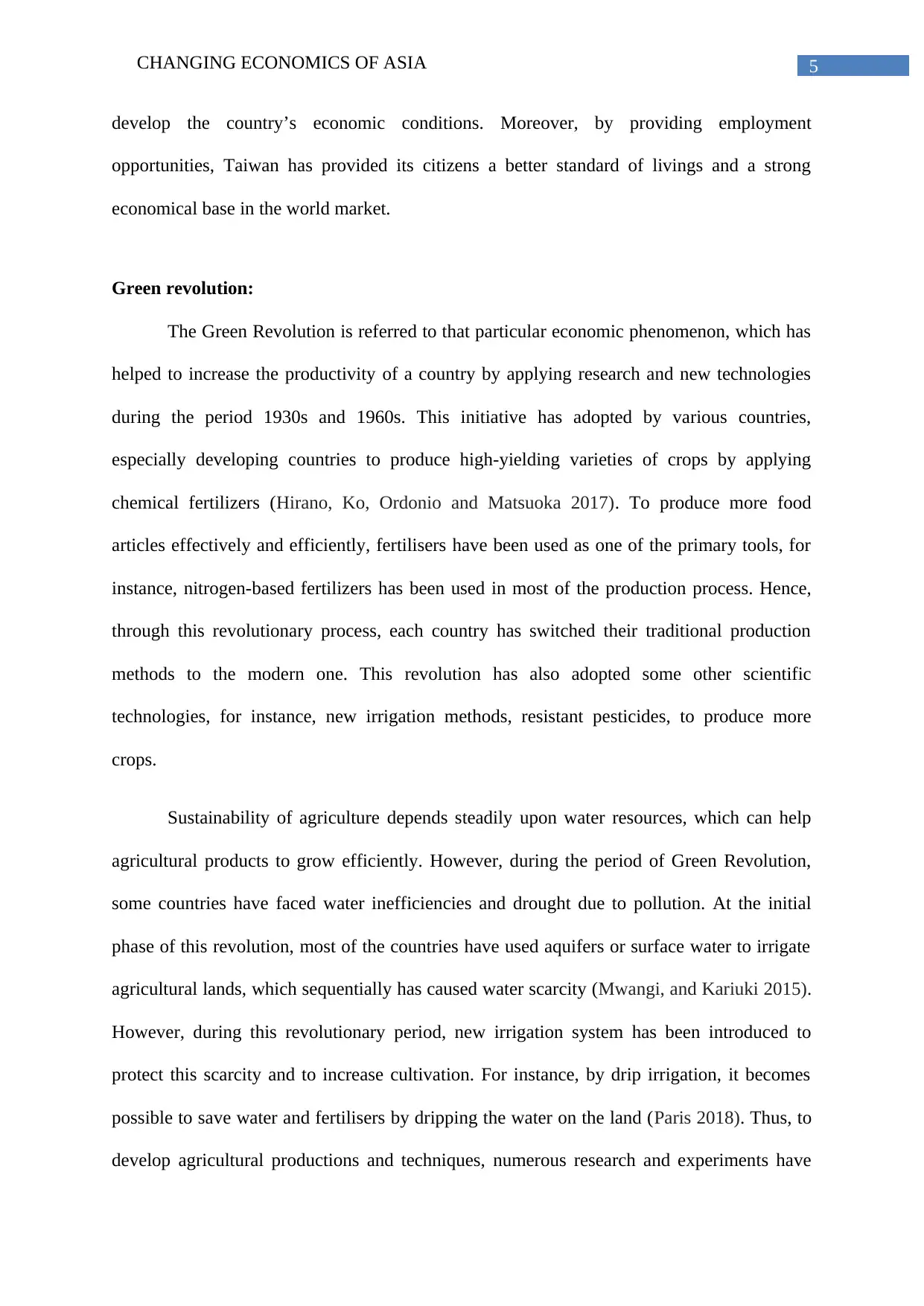
5CHANGING ECONOMICS OF ASIA
develop the country’s economic conditions. Moreover, by providing employment
opportunities, Taiwan has provided its citizens a better standard of livings and a strong
economical base in the world market.
Green revolution:
The Green Revolution is referred to that particular economic phenomenon, which has
helped to increase the productivity of a country by applying research and new technologies
during the period 1930s and 1960s. This initiative has adopted by various countries,
especially developing countries to produce high-yielding varieties of crops by applying
chemical fertilizers (Hirano, Ko, Ordonio and Matsuoka 2017). To produce more food
articles effectively and efficiently, fertilisers have been used as one of the primary tools, for
instance, nitrogen-based fertilizers has been used in most of the production process. Hence,
through this revolutionary process, each country has switched their traditional production
methods to the modern one. This revolution has also adopted some other scientific
technologies, for instance, new irrigation methods, resistant pesticides, to produce more
crops.
Sustainability of agriculture depends steadily upon water resources, which can help
agricultural products to grow efficiently. However, during the period of Green Revolution,
some countries have faced water inefficiencies and drought due to pollution. At the initial
phase of this revolution, most of the countries have used aquifers or surface water to irrigate
agricultural lands, which sequentially has caused water scarcity (Mwangi, and Kariuki 2015).
However, during this revolutionary period, new irrigation system has been introduced to
protect this scarcity and to increase cultivation. For instance, by drip irrigation, it becomes
possible to save water and fertilisers by dripping the water on the land (Paris 2018). Thus, to
develop agricultural productions and techniques, numerous research and experiments have
develop the country’s economic conditions. Moreover, by providing employment
opportunities, Taiwan has provided its citizens a better standard of livings and a strong
economical base in the world market.
Green revolution:
The Green Revolution is referred to that particular economic phenomenon, which has
helped to increase the productivity of a country by applying research and new technologies
during the period 1930s and 1960s. This initiative has adopted by various countries,
especially developing countries to produce high-yielding varieties of crops by applying
chemical fertilizers (Hirano, Ko, Ordonio and Matsuoka 2017). To produce more food
articles effectively and efficiently, fertilisers have been used as one of the primary tools, for
instance, nitrogen-based fertilizers has been used in most of the production process. Hence,
through this revolutionary process, each country has switched their traditional production
methods to the modern one. This revolution has also adopted some other scientific
technologies, for instance, new irrigation methods, resistant pesticides, to produce more
crops.
Sustainability of agriculture depends steadily upon water resources, which can help
agricultural products to grow efficiently. However, during the period of Green Revolution,
some countries have faced water inefficiencies and drought due to pollution. At the initial
phase of this revolution, most of the countries have used aquifers or surface water to irrigate
agricultural lands, which sequentially has caused water scarcity (Mwangi, and Kariuki 2015).
However, during this revolutionary period, new irrigation system has been introduced to
protect this scarcity and to increase cultivation. For instance, by drip irrigation, it becomes
possible to save water and fertilisers by dripping the water on the land (Paris 2018). Thus, to
develop agricultural productions and techniques, numerous research and experiments have
⊘ This is a preview!⊘
Do you want full access?
Subscribe today to unlock all pages.

Trusted by 1+ million students worldwide
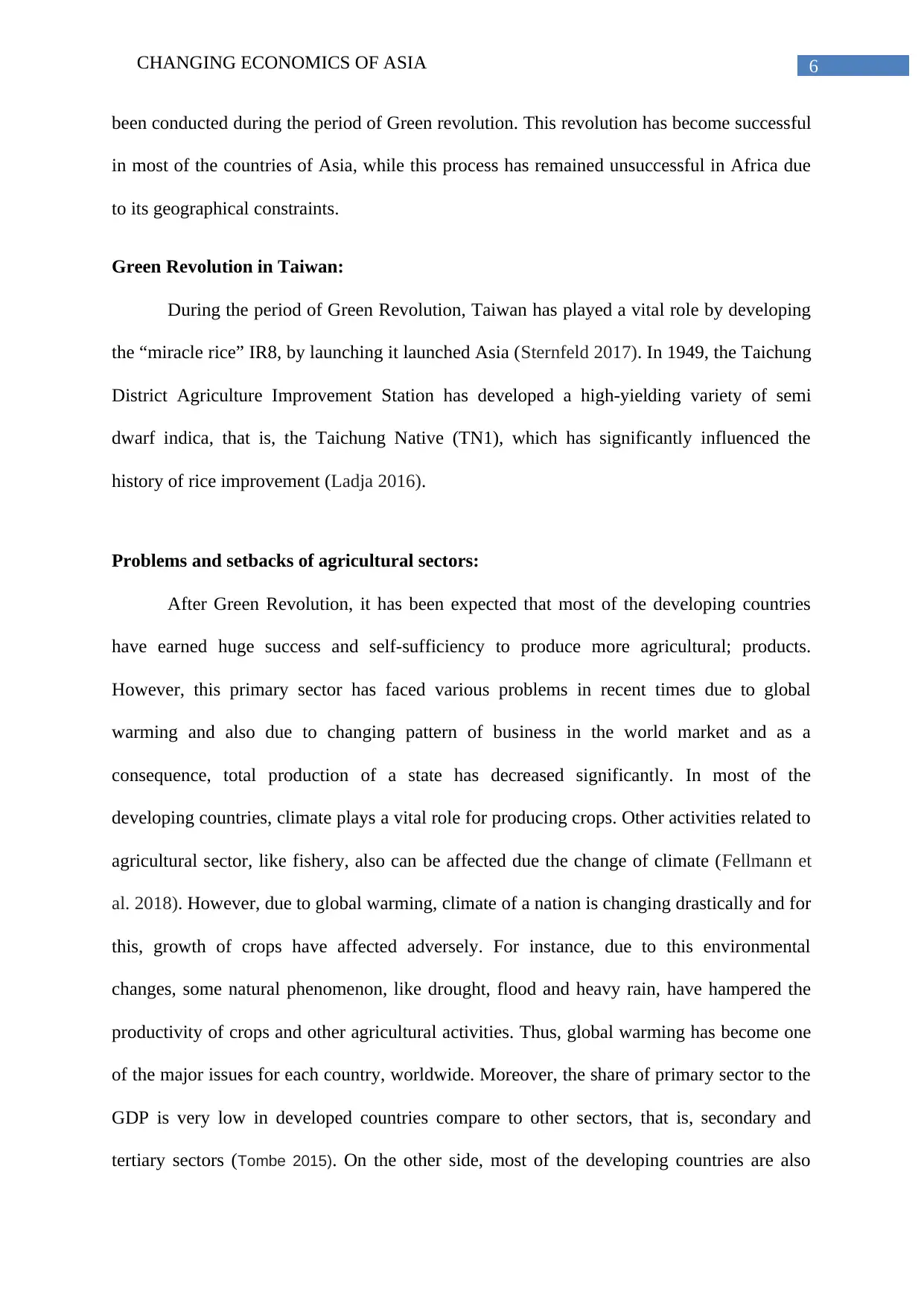
6CHANGING ECONOMICS OF ASIA
been conducted during the period of Green revolution. This revolution has become successful
in most of the countries of Asia, while this process has remained unsuccessful in Africa due
to its geographical constraints.
Green Revolution in Taiwan:
During the period of Green Revolution, Taiwan has played a vital role by developing
the “miracle rice” IR8, by launching it launched Asia (Sternfeld 2017). In 1949, the Taichung
District Agriculture Improvement Station has developed a high-yielding variety of semi
dwarf indica, that is, the Taichung Native (TN1), which has significantly influenced the
history of rice improvement (Ladja 2016).
Problems and setbacks of agricultural sectors:
After Green Revolution, it has been expected that most of the developing countries
have earned huge success and self-sufficiency to produce more agricultural; products.
However, this primary sector has faced various problems in recent times due to global
warming and also due to changing pattern of business in the world market and as a
consequence, total production of a state has decreased significantly. In most of the
developing countries, climate plays a vital role for producing crops. Other activities related to
agricultural sector, like fishery, also can be affected due the change of climate (Fellmann et
al. 2018). However, due to global warming, climate of a nation is changing drastically and for
this, growth of crops have affected adversely. For instance, due to this environmental
changes, some natural phenomenon, like drought, flood and heavy rain, have hampered the
productivity of crops and other agricultural activities. Thus, global warming has become one
of the major issues for each country, worldwide. Moreover, the share of primary sector to the
GDP is very low in developed countries compare to other sectors, that is, secondary and
tertiary sectors (Tombe 2015). On the other side, most of the developing countries are also
been conducted during the period of Green revolution. This revolution has become successful
in most of the countries of Asia, while this process has remained unsuccessful in Africa due
to its geographical constraints.
Green Revolution in Taiwan:
During the period of Green Revolution, Taiwan has played a vital role by developing
the “miracle rice” IR8, by launching it launched Asia (Sternfeld 2017). In 1949, the Taichung
District Agriculture Improvement Station has developed a high-yielding variety of semi
dwarf indica, that is, the Taichung Native (TN1), which has significantly influenced the
history of rice improvement (Ladja 2016).
Problems and setbacks of agricultural sectors:
After Green Revolution, it has been expected that most of the developing countries
have earned huge success and self-sufficiency to produce more agricultural; products.
However, this primary sector has faced various problems in recent times due to global
warming and also due to changing pattern of business in the world market and as a
consequence, total production of a state has decreased significantly. In most of the
developing countries, climate plays a vital role for producing crops. Other activities related to
agricultural sector, like fishery, also can be affected due the change of climate (Fellmann et
al. 2018). However, due to global warming, climate of a nation is changing drastically and for
this, growth of crops have affected adversely. For instance, due to this environmental
changes, some natural phenomenon, like drought, flood and heavy rain, have hampered the
productivity of crops and other agricultural activities. Thus, global warming has become one
of the major issues for each country, worldwide. Moreover, the share of primary sector to the
GDP is very low in developed countries compare to other sectors, that is, secondary and
tertiary sectors (Tombe 2015). On the other side, most of the developing countries are also
Paraphrase This Document
Need a fresh take? Get an instant paraphrase of this document with our AI Paraphraser
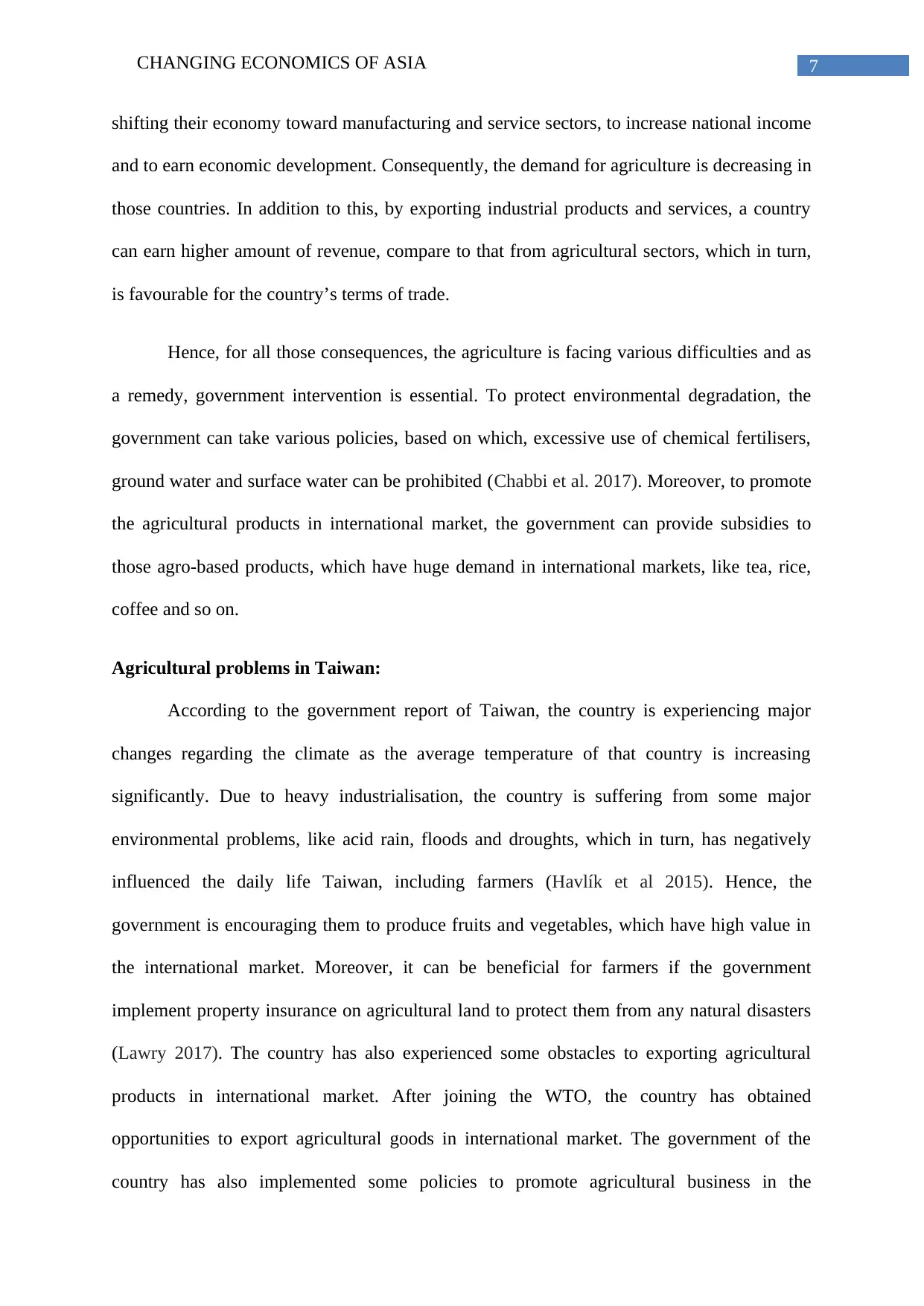
7CHANGING ECONOMICS OF ASIA
shifting their economy toward manufacturing and service sectors, to increase national income
and to earn economic development. Consequently, the demand for agriculture is decreasing in
those countries. In addition to this, by exporting industrial products and services, a country
can earn higher amount of revenue, compare to that from agricultural sectors, which in turn,
is favourable for the country’s terms of trade.
Hence, for all those consequences, the agriculture is facing various difficulties and as
a remedy, government intervention is essential. To protect environmental degradation, the
government can take various policies, based on which, excessive use of chemical fertilisers,
ground water and surface water can be prohibited (Chabbi et al. 2017). Moreover, to promote
the agricultural products in international market, the government can provide subsidies to
those agro-based products, which have huge demand in international markets, like tea, rice,
coffee and so on.
Agricultural problems in Taiwan:
According to the government report of Taiwan, the country is experiencing major
changes regarding the climate as the average temperature of that country is increasing
significantly. Due to heavy industrialisation, the country is suffering from some major
environmental problems, like acid rain, floods and droughts, which in turn, has negatively
influenced the daily life Taiwan, including farmers (Havlík et al 2015). Hence, the
government is encouraging them to produce fruits and vegetables, which have high value in
the international market. Moreover, it can be beneficial for farmers if the government
implement property insurance on agricultural land to protect them from any natural disasters
(Lawry 2017). The country has also experienced some obstacles to exporting agricultural
products in international market. After joining the WTO, the country has obtained
opportunities to export agricultural goods in international market. The government of the
country has also implemented some policies to promote agricultural business in the
shifting their economy toward manufacturing and service sectors, to increase national income
and to earn economic development. Consequently, the demand for agriculture is decreasing in
those countries. In addition to this, by exporting industrial products and services, a country
can earn higher amount of revenue, compare to that from agricultural sectors, which in turn,
is favourable for the country’s terms of trade.
Hence, for all those consequences, the agriculture is facing various difficulties and as
a remedy, government intervention is essential. To protect environmental degradation, the
government can take various policies, based on which, excessive use of chemical fertilisers,
ground water and surface water can be prohibited (Chabbi et al. 2017). Moreover, to promote
the agricultural products in international market, the government can provide subsidies to
those agro-based products, which have huge demand in international markets, like tea, rice,
coffee and so on.
Agricultural problems in Taiwan:
According to the government report of Taiwan, the country is experiencing major
changes regarding the climate as the average temperature of that country is increasing
significantly. Due to heavy industrialisation, the country is suffering from some major
environmental problems, like acid rain, floods and droughts, which in turn, has negatively
influenced the daily life Taiwan, including farmers (Havlík et al 2015). Hence, the
government is encouraging them to produce fruits and vegetables, which have high value in
the international market. Moreover, it can be beneficial for farmers if the government
implement property insurance on agricultural land to protect them from any natural disasters
(Lawry 2017). The country has also experienced some obstacles to exporting agricultural
products in international market. After joining the WTO, the country has obtained
opportunities to export agricultural goods in international market. The government of the
country has also implemented some policies to promote agricultural business in the
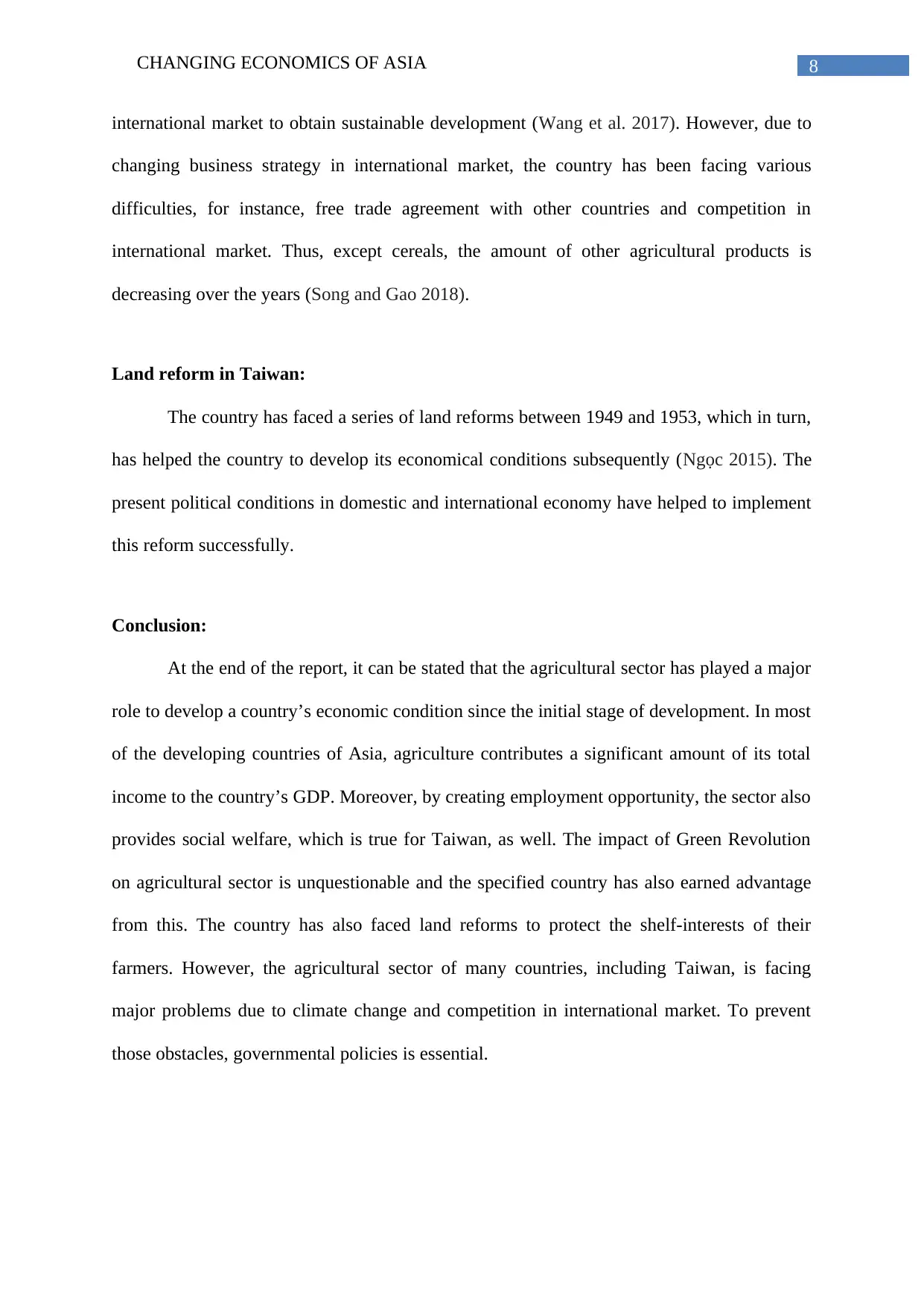
8CHANGING ECONOMICS OF ASIA
international market to obtain sustainable development (Wang et al. 2017). However, due to
changing business strategy in international market, the country has been facing various
difficulties, for instance, free trade agreement with other countries and competition in
international market. Thus, except cereals, the amount of other agricultural products is
decreasing over the years (Song and Gao 2018).
Land reform in Taiwan:
The country has faced a series of land reforms between 1949 and 1953, which in turn,
has helped the country to develop its economical conditions subsequently (Ngọc 2015). The
present political conditions in domestic and international economy have helped to implement
this reform successfully.
Conclusion:
At the end of the report, it can be stated that the agricultural sector has played a major
role to develop a country’s economic condition since the initial stage of development. In most
of the developing countries of Asia, agriculture contributes a significant amount of its total
income to the country’s GDP. Moreover, by creating employment opportunity, the sector also
provides social welfare, which is true for Taiwan, as well. The impact of Green Revolution
on agricultural sector is unquestionable and the specified country has also earned advantage
from this. The country has also faced land reforms to protect the shelf-interests of their
farmers. However, the agricultural sector of many countries, including Taiwan, is facing
major problems due to climate change and competition in international market. To prevent
those obstacles, governmental policies is essential.
international market to obtain sustainable development (Wang et al. 2017). However, due to
changing business strategy in international market, the country has been facing various
difficulties, for instance, free trade agreement with other countries and competition in
international market. Thus, except cereals, the amount of other agricultural products is
decreasing over the years (Song and Gao 2018).
Land reform in Taiwan:
The country has faced a series of land reforms between 1949 and 1953, which in turn,
has helped the country to develop its economical conditions subsequently (Ngọc 2015). The
present political conditions in domestic and international economy have helped to implement
this reform successfully.
Conclusion:
At the end of the report, it can be stated that the agricultural sector has played a major
role to develop a country’s economic condition since the initial stage of development. In most
of the developing countries of Asia, agriculture contributes a significant amount of its total
income to the country’s GDP. Moreover, by creating employment opportunity, the sector also
provides social welfare, which is true for Taiwan, as well. The impact of Green Revolution
on agricultural sector is unquestionable and the specified country has also earned advantage
from this. The country has also faced land reforms to protect the shelf-interests of their
farmers. However, the agricultural sector of many countries, including Taiwan, is facing
major problems due to climate change and competition in international market. To prevent
those obstacles, governmental policies is essential.
⊘ This is a preview!⊘
Do you want full access?
Subscribe today to unlock all pages.

Trusted by 1+ million students worldwide
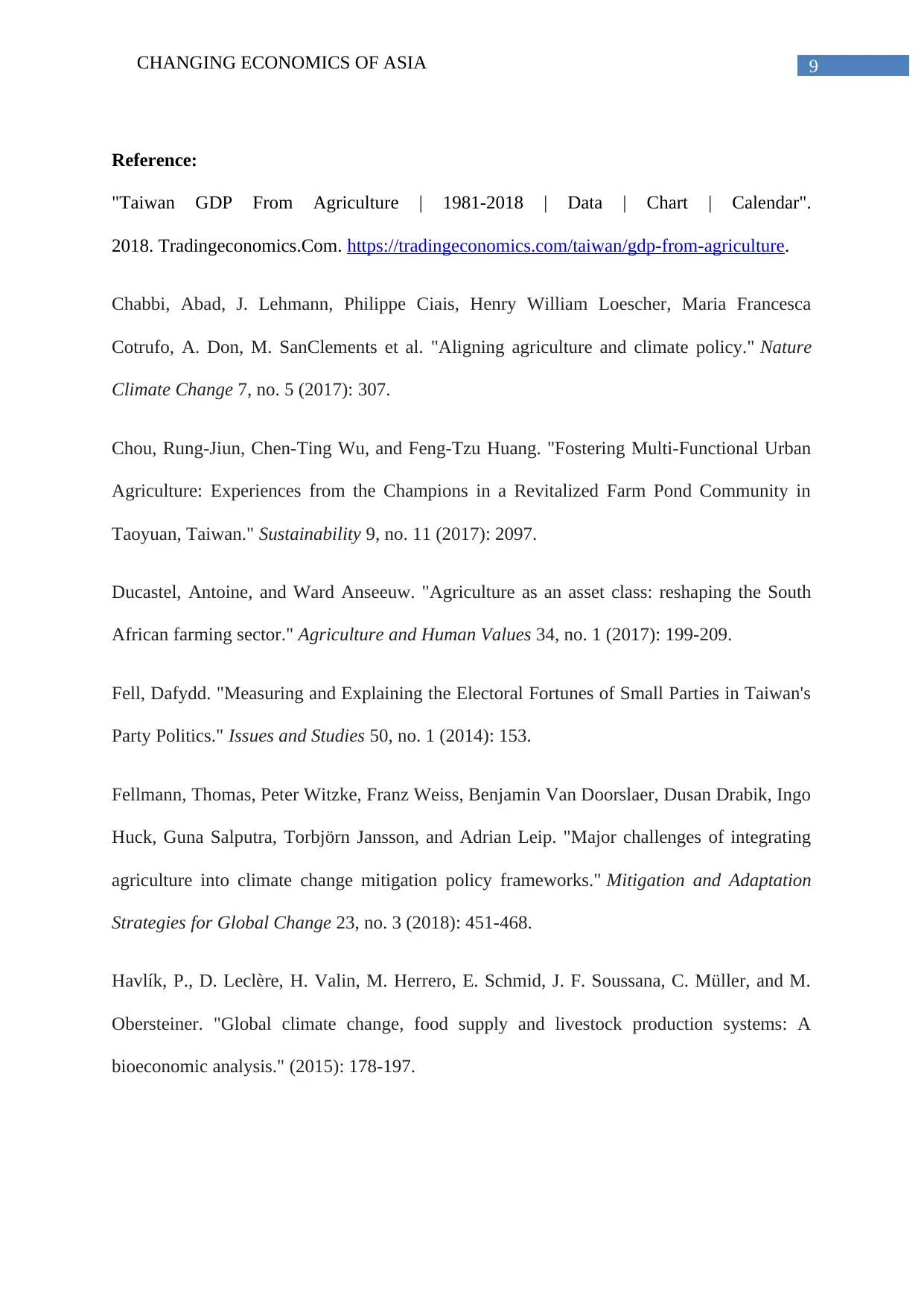
9CHANGING ECONOMICS OF ASIA
Reference:
"Taiwan GDP From Agriculture | 1981-2018 | Data | Chart | Calendar".
2018. Tradingeconomics.Com. https://tradingeconomics.com/taiwan/gdp-from-agriculture.
Chabbi, Abad, J. Lehmann, Philippe Ciais, Henry William Loescher, Maria Francesca
Cotrufo, A. Don, M. SanClements et al. "Aligning agriculture and climate policy." Nature
Climate Change 7, no. 5 (2017): 307.
Chou, Rung-Jiun, Chen-Ting Wu, and Feng-Tzu Huang. "Fostering Multi-Functional Urban
Agriculture: Experiences from the Champions in a Revitalized Farm Pond Community in
Taoyuan, Taiwan." Sustainability 9, no. 11 (2017): 2097.
Ducastel, Antoine, and Ward Anseeuw. "Agriculture as an asset class: reshaping the South
African farming sector." Agriculture and Human Values 34, no. 1 (2017): 199-209.
Fell, Dafydd. "Measuring and Explaining the Electoral Fortunes of Small Parties in Taiwan's
Party Politics." Issues and Studies 50, no. 1 (2014): 153.
Fellmann, Thomas, Peter Witzke, Franz Weiss, Benjamin Van Doorslaer, Dusan Drabik, Ingo
Huck, Guna Salputra, Torbjörn Jansson, and Adrian Leip. "Major challenges of integrating
agriculture into climate change mitigation policy frameworks." Mitigation and Adaptation
Strategies for Global Change 23, no. 3 (2018): 451-468.
Havlík, P., D. Leclère, H. Valin, M. Herrero, E. Schmid, J. F. Soussana, C. Müller, and M.
Obersteiner. "Global climate change, food supply and livestock production systems: A
bioeconomic analysis." (2015): 178-197.
Reference:
"Taiwan GDP From Agriculture | 1981-2018 | Data | Chart | Calendar".
2018. Tradingeconomics.Com. https://tradingeconomics.com/taiwan/gdp-from-agriculture.
Chabbi, Abad, J. Lehmann, Philippe Ciais, Henry William Loescher, Maria Francesca
Cotrufo, A. Don, M. SanClements et al. "Aligning agriculture and climate policy." Nature
Climate Change 7, no. 5 (2017): 307.
Chou, Rung-Jiun, Chen-Ting Wu, and Feng-Tzu Huang. "Fostering Multi-Functional Urban
Agriculture: Experiences from the Champions in a Revitalized Farm Pond Community in
Taoyuan, Taiwan." Sustainability 9, no. 11 (2017): 2097.
Ducastel, Antoine, and Ward Anseeuw. "Agriculture as an asset class: reshaping the South
African farming sector." Agriculture and Human Values 34, no. 1 (2017): 199-209.
Fell, Dafydd. "Measuring and Explaining the Electoral Fortunes of Small Parties in Taiwan's
Party Politics." Issues and Studies 50, no. 1 (2014): 153.
Fellmann, Thomas, Peter Witzke, Franz Weiss, Benjamin Van Doorslaer, Dusan Drabik, Ingo
Huck, Guna Salputra, Torbjörn Jansson, and Adrian Leip. "Major challenges of integrating
agriculture into climate change mitigation policy frameworks." Mitigation and Adaptation
Strategies for Global Change 23, no. 3 (2018): 451-468.
Havlík, P., D. Leclère, H. Valin, M. Herrero, E. Schmid, J. F. Soussana, C. Müller, and M.
Obersteiner. "Global climate change, food supply and livestock production systems: A
bioeconomic analysis." (2015): 178-197.
Paraphrase This Document
Need a fresh take? Get an instant paraphrase of this document with our AI Paraphraser
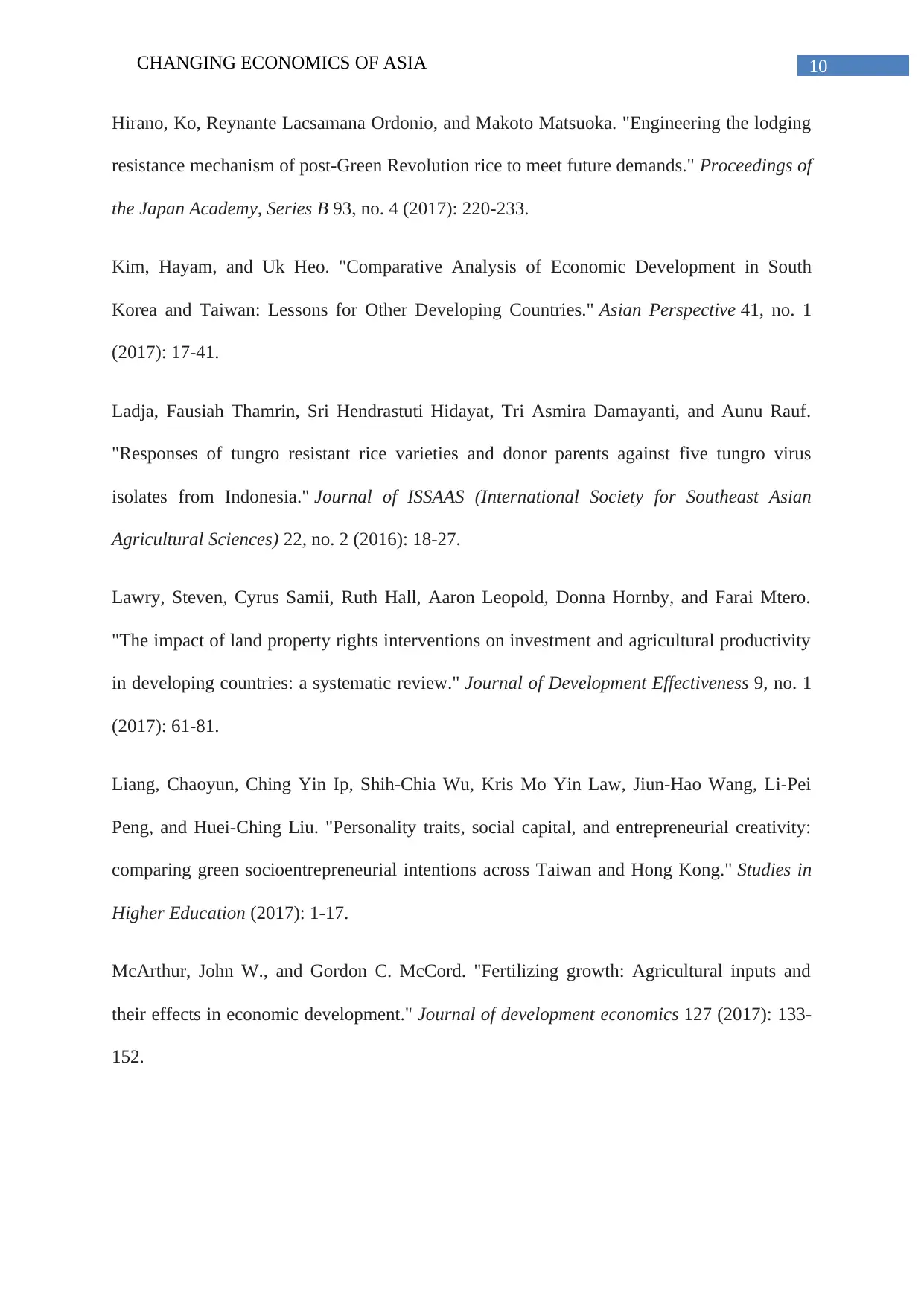
10CHANGING ECONOMICS OF ASIA
Hirano, Ko, Reynante Lacsamana Ordonio, and Makoto Matsuoka. "Engineering the lodging
resistance mechanism of post-Green Revolution rice to meet future demands." Proceedings of
the Japan Academy, Series B 93, no. 4 (2017): 220-233.
Kim, Hayam, and Uk Heo. "Comparative Analysis of Economic Development in South
Korea and Taiwan: Lessons for Other Developing Countries." Asian Perspective 41, no. 1
(2017): 17-41.
Ladja, Fausiah Thamrin, Sri Hendrastuti Hidayat, Tri Asmira Damayanti, and Aunu Rauf.
"Responses of tungro resistant rice varieties and donor parents against five tungro virus
isolates from Indonesia." Journal of ISSAAS (International Society for Southeast Asian
Agricultural Sciences) 22, no. 2 (2016): 18-27.
Lawry, Steven, Cyrus Samii, Ruth Hall, Aaron Leopold, Donna Hornby, and Farai Mtero.
"The impact of land property rights interventions on investment and agricultural productivity
in developing countries: a systematic review." Journal of Development Effectiveness 9, no. 1
(2017): 61-81.
Liang, Chaoyun, Ching Yin Ip, Shih-Chia Wu, Kris Mo Yin Law, Jiun-Hao Wang, Li-Pei
Peng, and Huei-Ching Liu. "Personality traits, social capital, and entrepreneurial creativity:
comparing green socioentrepreneurial intentions across Taiwan and Hong Kong." Studies in
Higher Education (2017): 1-17.
McArthur, John W., and Gordon C. McCord. "Fertilizing growth: Agricultural inputs and
their effects in economic development." Journal of development economics 127 (2017): 133-
152.
Hirano, Ko, Reynante Lacsamana Ordonio, and Makoto Matsuoka. "Engineering the lodging
resistance mechanism of post-Green Revolution rice to meet future demands." Proceedings of
the Japan Academy, Series B 93, no. 4 (2017): 220-233.
Kim, Hayam, and Uk Heo. "Comparative Analysis of Economic Development in South
Korea and Taiwan: Lessons for Other Developing Countries." Asian Perspective 41, no. 1
(2017): 17-41.
Ladja, Fausiah Thamrin, Sri Hendrastuti Hidayat, Tri Asmira Damayanti, and Aunu Rauf.
"Responses of tungro resistant rice varieties and donor parents against five tungro virus
isolates from Indonesia." Journal of ISSAAS (International Society for Southeast Asian
Agricultural Sciences) 22, no. 2 (2016): 18-27.
Lawry, Steven, Cyrus Samii, Ruth Hall, Aaron Leopold, Donna Hornby, and Farai Mtero.
"The impact of land property rights interventions on investment and agricultural productivity
in developing countries: a systematic review." Journal of Development Effectiveness 9, no. 1
(2017): 61-81.
Liang, Chaoyun, Ching Yin Ip, Shih-Chia Wu, Kris Mo Yin Law, Jiun-Hao Wang, Li-Pei
Peng, and Huei-Ching Liu. "Personality traits, social capital, and entrepreneurial creativity:
comparing green socioentrepreneurial intentions across Taiwan and Hong Kong." Studies in
Higher Education (2017): 1-17.
McArthur, John W., and Gordon C. McCord. "Fertilizing growth: Agricultural inputs and
their effects in economic development." Journal of development economics 127 (2017): 133-
152.
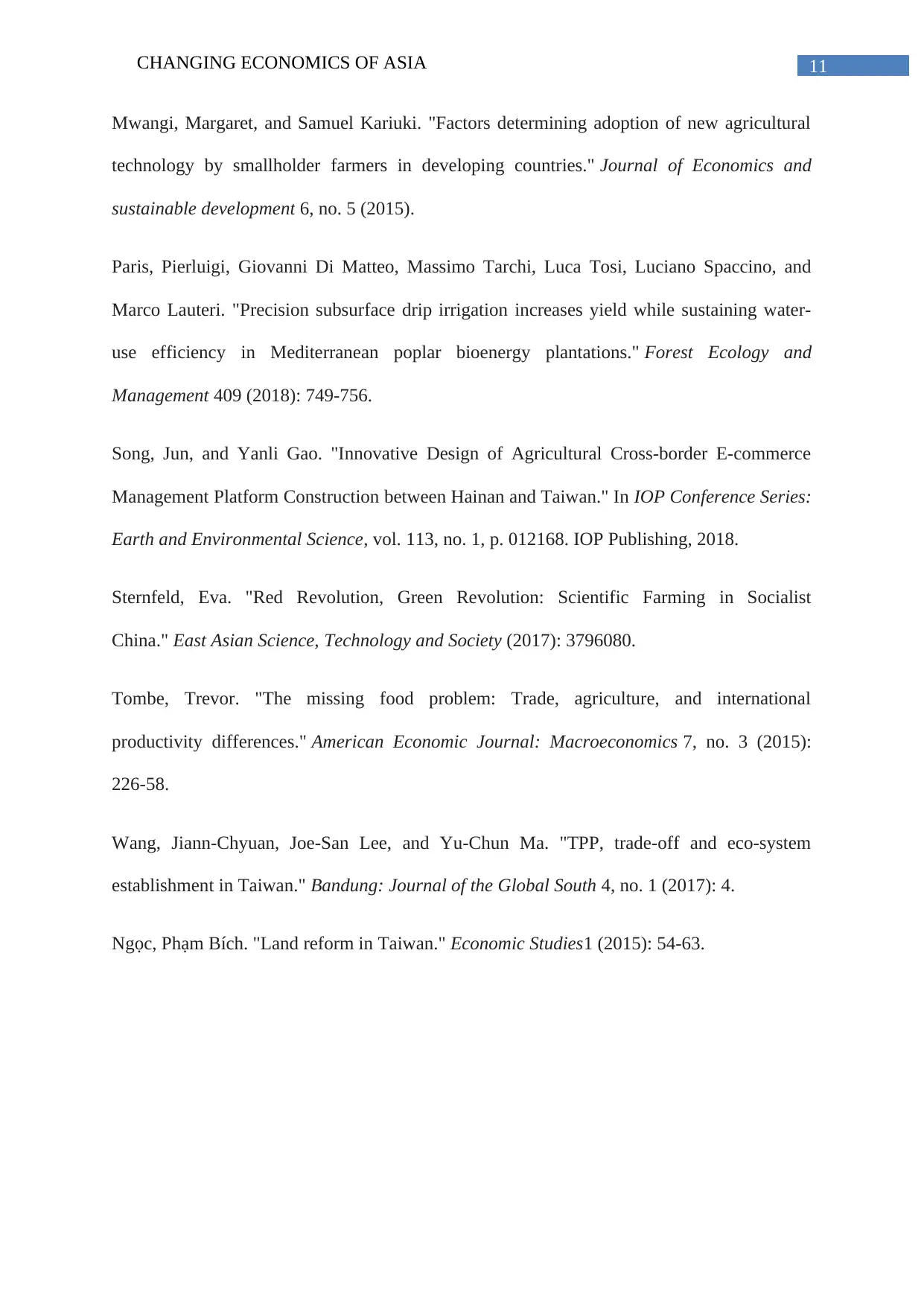
11CHANGING ECONOMICS OF ASIA
Mwangi, Margaret, and Samuel Kariuki. "Factors determining adoption of new agricultural
technology by smallholder farmers in developing countries." Journal of Economics and
sustainable development 6, no. 5 (2015).
Paris, Pierluigi, Giovanni Di Matteo, Massimo Tarchi, Luca Tosi, Luciano Spaccino, and
Marco Lauteri. "Precision subsurface drip irrigation increases yield while sustaining water-
use efficiency in Mediterranean poplar bioenergy plantations." Forest Ecology and
Management 409 (2018): 749-756.
Song, Jun, and Yanli Gao. "Innovative Design of Agricultural Cross-border E-commerce
Management Platform Construction between Hainan and Taiwan." In IOP Conference Series:
Earth and Environmental Science, vol. 113, no. 1, p. 012168. IOP Publishing, 2018.
Sternfeld, Eva. "Red Revolution, Green Revolution: Scientific Farming in Socialist
China." East Asian Science, Technology and Society (2017): 3796080.
Tombe, Trevor. "The missing food problem: Trade, agriculture, and international
productivity differences." American Economic Journal: Macroeconomics 7, no. 3 (2015):
226-58.
Wang, Jiann-Chyuan, Joe-San Lee, and Yu-Chun Ma. "TPP, trade-off and eco-system
establishment in Taiwan." Bandung: Journal of the Global South 4, no. 1 (2017): 4.
Ngọc, Phạm Bích. "Land reform in Taiwan." Economic Studies1 (2015): 54-63.
Mwangi, Margaret, and Samuel Kariuki. "Factors determining adoption of new agricultural
technology by smallholder farmers in developing countries." Journal of Economics and
sustainable development 6, no. 5 (2015).
Paris, Pierluigi, Giovanni Di Matteo, Massimo Tarchi, Luca Tosi, Luciano Spaccino, and
Marco Lauteri. "Precision subsurface drip irrigation increases yield while sustaining water-
use efficiency in Mediterranean poplar bioenergy plantations." Forest Ecology and
Management 409 (2018): 749-756.
Song, Jun, and Yanli Gao. "Innovative Design of Agricultural Cross-border E-commerce
Management Platform Construction between Hainan and Taiwan." In IOP Conference Series:
Earth and Environmental Science, vol. 113, no. 1, p. 012168. IOP Publishing, 2018.
Sternfeld, Eva. "Red Revolution, Green Revolution: Scientific Farming in Socialist
China." East Asian Science, Technology and Society (2017): 3796080.
Tombe, Trevor. "The missing food problem: Trade, agriculture, and international
productivity differences." American Economic Journal: Macroeconomics 7, no. 3 (2015):
226-58.
Wang, Jiann-Chyuan, Joe-San Lee, and Yu-Chun Ma. "TPP, trade-off and eco-system
establishment in Taiwan." Bandung: Journal of the Global South 4, no. 1 (2017): 4.
Ngọc, Phạm Bích. "Land reform in Taiwan." Economic Studies1 (2015): 54-63.
⊘ This is a preview!⊘
Do you want full access?
Subscribe today to unlock all pages.

Trusted by 1+ million students worldwide
1 out of 13
Related Documents
Your All-in-One AI-Powered Toolkit for Academic Success.
+13062052269
info@desklib.com
Available 24*7 on WhatsApp / Email
![[object Object]](/_next/static/media/star-bottom.7253800d.svg)
Unlock your academic potential
Copyright © 2020–2025 A2Z Services. All Rights Reserved. Developed and managed by ZUCOL.





